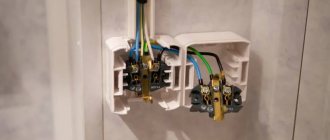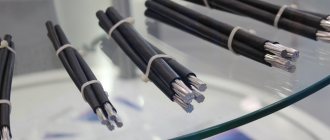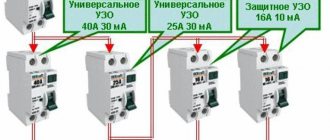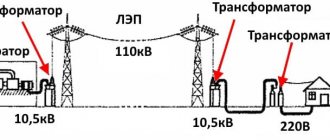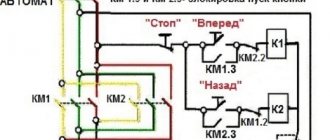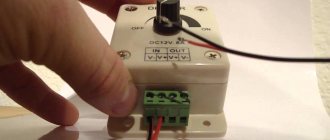Electric current is the ordered movement of charged particles in a conductor. Leakage current is no exception. Under normal conditions, electric current flows through the conductors inside the electrical installation, as intended by the designer and developer. The conductors are separated from the remaining current-carrying structural elements (metal body, frame, frame) by insulation, the resistance of which does not allow the creation of an electrical circuit.
If the insulation resistance has decreased for some reason (damage, humidity, conductive dust, etc.), a potential (phase) appears on the housing or other conductive elements of the installation. The leakage current itself will not occur; it is necessary to create a circuit connecting the electrical device with the potential on the housing to ground or neutral.
What is leakage current?
The main thing you need to know is that there is always leakage current, and if it is present, this is normal. Moreover, I cannot imagine a situation when this current will not exist. Maybe only in an ideal world, where the resistance of insulation and all objects not intended to conduct current is equal to infinity.
The official definition is in GOST IEC 61008-1-2020 (the main GOST for VDT, if anyone doesn’t know) (clause 3.1.2): leakage current is “the current that flows into the ground or onto third-party conductive parts in an electrically intact circuit "
The leakage current “flows”, contrary to Kirchhoff’s first law, from the phase conductor to the ground. In this case, ground is considered to be everything that is electrically connected to the grounded neutral of the transformer at the transformer substation, and at the entrance to the house - to the main switch and the ground loop.
Write in the comments whether in this case the 1st law of grandfather Kirchhoff is violated?
In addition, there is also a capacitive component of the leakage current - after all, any cable and many devices (for example, heating elements) can be represented as a capacitor that has a reactance at a frequency (in this case) of 50 Hz.
In the picture below, I depicted, as far as my design abilities allow me, a typical situation - a TN-CS system, re-grounding, an RCD as a symbol of a threshold device that responds to leakage current, and the leakage current itself (dotted line):
Ground leakage current
The current leakage that occurs before the RCD (VDT) is not detected in any way and does not participate in the operation of the VDT.
There are tables that designers use to determine (plus or minus a tram stop)) the leakage current of various household appliances. For those interested, information is available in GOST IEC 60335-1-2015:
Permissible leakage currents of household appliances
Most household electrical appliances have a class I level of leakage current.
As for electrical wiring, the leakage current is estimated with approximately the same accuracy according to the PUE, clause 7.1.83: “(...) the leakage current of electrical receivers should be taken at the rate of 0.4 mA per 1 A of load current, and the network leakage current at the rate of 10 µA per 1 m length of phase conductor.
That is, if only a heater with an operating current of 10 A is connected to this group at a distance of 100 m, the leakage current of such an installation will be calculated as follows: 0.4 mA x 10 A = 4 mA (electrical receiver leakage), plus 0.01 mA x 100 m = 1 mA. In total, a leakage current during operation of such a heater of 5 mA will be the norm. And according to the same clause 7.1.83, RCCBs with IΔn = 10 mA cannot be placed in such a group - the background (normal, or operating) leakage current must be 3 times less than IΔn. Otherwise, get tired of running a hundred meters!
Leakage current direction
Ground leakage current
The direction of the currents depends on the type of grounding:
- Insulated neutral IT - leakage occurs through the insulating layer to conductive elements. From them, it is diverted through conductors to the spreading area.
- TN circuit with solidly grounded neutral - leakage passes through the REN bus to the input protection device.
- CT system - leakage occurs through the main insulation from live to exposed conductive elements. The current is directed through the conductor and ground electrode to the local soil.
The direction and path of current in IT and CT circuits are the same.
Features of wiring testing
The main potential threat from a leak in hidden wiring is damage during wallpapering or applying plaster. There are ways to detect defects without turning to professionals. One of the long-proven and popular options is a conventional transistor receiver with a reception range of long and medium waves.
At the beginning of the upcoming event, make sure that all energy consumers are turned off. We tune the receiver to a frequency free from broadcasting and slowly move with it along the cable laying areas in the walls. In the immediate vicinity of places with leaks, a specific manifestation in the dynamics of background noise is observed.
Is every leak bad?
Leakage current is the unplanned current flowing in an electrical circuit. Ideal leakage values are zero, but this does not mean that any number above 0 is bad.
Modern cars are “stuffed” with a variety of devices: alarms, clocks, ECU memory (electronic control unit) and much more are connected to the network and consume electrical energy, not from time to time, but constantly. For example, when the car is not running, security systems begin to function. This means that some kind of loss of electricity, that is, current leakage, is acceptable, the main thing is that the values are not higher than normal.
This norm can be represented as a constant value, that is, it can be calculated by summing up the consumption of each element in the on-board network. Let's imagine that the security system takes a maximum of 20 mA, the clock 1 mA, etc. The total figure can reach up to 80 mA (0.08A), but it all depends on the specific car.
For example, in passenger cars, a current leak of a maximum of 40 mA can be considered normal if only standard electronics are functioning. When installing additional devices, the permissible value increases to 80. This includes speakers, emergency alarms, etc.
Testing of valve arresters
Overvoltages may occur at the terminals of electrical installation equipment during switching of electrical circuits, lightning strikes, etc., which pose a danger to the insulation of the equipment. The main means of limiting overvoltages are valve arresters.
The protective effect of the arrester is determined by the fact that when a dangerous overvoltage occurs in the insulation, a breakdown of the spark gap of the arrester occurs, and the pulse current flowing through the arrester due to the nonlinearity of the operating resistance does not create a voltage increase that is dangerous for the insulation. Valve arresters of various designs are used. The following letter designations for the types of arresters are accepted: P - arrester; B - valve; O - lightweight; C - station; M - magnetic or upgraded; T - with current-limiting spark gaps or tropical design (if T appears after the number); P - increased quenching voltage; G - thunderstorm; RD - with a stretching arc; U - for work in areas with temperate climates; the number after the hyphen is the rated voltage, kV; number 1 - for working outdoors. For example, RVMG-110MT1 valve-type arrester, with magnetic damping, lightning, for a voltage of 110 kV, modernized, with current-limiting spark gaps, for work in the open air. According to their purpose, valve arresters are divided into: to protect electrical equipment from atmospheric overvoltages (RVO, RVS, RVMG, RVMA, RVP); to protect machines and equipment from atmospheric and short-term internal overvoltages (RVRD, RVMA, RVVM, RVM); to protect traction electrical equipment from overvoltages (RMVU).
To protect high-voltage electrical equipment (60 kV and above) from lightning overvoltages, arresters are assembled from standard elements (RVS type arresters - from elements with a voltage of 15, 20, 30, 33 or 35 kV; RVMG type arresters - from standardized working elements RVMG-30) RVP is a valve substation arrester, lightweight in design and without shunt resistances.
Causes of current leakage
Leakage occurs even when the equipment is operating normally, but danger arises when the differential current limit is exceeded. The permissible rate may increase in several cases.
From an electrical appliance in an apartment or house
Breakdown to the housing in systems: A) TN-CS, B) TN-C
Voltage occurs on the body of household appliances (most often a water heater or automatic machine). The reason is damage to the heating element or breaks in the insulation. In a three-wire or two-wire equipment connection diagram, the phenomenon manifests itself in different ways:
- Three-wire connection of the device according to the TN-CS scheme. In case of breakdowns of the grounded housing, the leakage is directed to the PE bus. The electromagnetic or thermal protection of the circuit breaker on the supply line is activated.
- Two-wire connection of the device with grounding type TN-C. The leak will not cause the circuit breaker to trip and the equipment will continue to operate until a differential current is generated. The phenomenon will occur when touching the body, building element or water supply pipes. The leakage conductor from the device to the ground will be a person.
The greatest danger to life is the two-wire connection type.
In hidden wiring in a house or apartment
Damage to hidden cable insulation
It will be interesting➡ What is tension?
When wiring is hidden, there is a risk of damage to the insulated cable cores. They occur in the following cases:
- Exceeding the standard service life. An apartment in a building built in the 50s-90s of the 20th century is equipped with aluminum or copper wiring. According to VSN 58-88, copper current-carrying conductors are replaced once every 30 years, aluminum - once every 30 years.
- Incorrect use. Overloading the power supply leads to heating and destruction of the insulation of the power cable.
- Mechanical damage to current conductors. They occur when the installation technology is broken or the walls are drilled incorrectly.
The insulation has a constant resistance value, but if a leak is suspected, it must be checked.
Parameters checked by the arrester
At various stages of manufacturing and subsequent operation, limiters must be subjected to certain tests, which are regulated by the above ND:
- Insulation resistance – checked with a megohmmeter to monitor insulation;
- Conduction current – allows you to check the nonlinear resistance of vilitic disks;
- Exposure to electrical voltage - to test strength and stability in various modes;
- Partial discharges - used to test breakdown stability through amplitude current surges;
- Residual voltage – characterizes the device’s ability to accumulate charge;
- Mechanical strength – allows you to make sure that the shirt will withstand mechanical loads;
Rice. 1. Principle of testing mechanical strength - Tightness - determines the resistance of the housing to the penetration of moisture inside.
Characteristic signs
Leakage current path through a damaged rectifier diode
You can recognize current leakage by the following signs:
- slight tingling when touching the wall, pipes, household appliances;
- increased energy consumption for no apparent reason;
- starts to knock out plugs when several devices are turned on;
- interference and noise from a working radio;
- electrical appliances do not work when plugged in;
- electric shocks in the bathroom during water procedures.
To eliminate a phenomenon, you need to identify its cause.
How does it proceed
- Option one. The housing or frame of an electrical installation (refrigerator, system unit, washing machine, etc.) touches a metal conductor in contact with the ground. This could be a heating radiator, a damp concrete floor in an apartment, or another electrical installation connected to ground. At the point of contact, the circuit closes and the same leakage current occurs. What is the danger? Local heating of the contact point may cause a fire. If the contact is reliable, the current will increase to the threshold of the protection device (input circuit breaker on the power panel). With a weak touch, sparking and the same local heating will be observed. Most often, this leads to melting and further damage to the supply wires. In addition, this phenomenon provokes electromagnetic interference.
- Option two. The electrical installation housing does not have contact with grounded objects and is not itself grounded. When a person touches the external panels, a load occurs (the human body is a conductor), and an electric current flows through the body. Since the resistance in this case is high, the current strength is insufficient to trip the circuit breakers. But harm to health, even death, can be caused. It is unacceptable to rely on the user to wear shoes with rubber soles. It’s the same as thinking that a linoleum-coated floor protects you from electric shock. Moreover, when the washing machine is operating, the owner’s hands are most often wet, which reduces the resistance of the skin.
And if in the first case a properly selected circuit breaker is sufficient, the second option requires more advanced measures. For example, the inclusion of an RCD in the power circuit, which reacts to a small leakage current rating, provokes the operation of a circuit breaker.
Important: Even if you are confident that electrical installations and current-carrying lines are in good condition, periodic checking of current leakage is mandatory in each room.
How can you determine whether there is a problem or not? To measure the leakage current, they usually call a team of master electricians who search for problematic installations using the device. At industrial facilities, this procedure is mandatory, as well as when commissioning housing stock. At large enterprises in big cities, such as Moscow, there are even full-time departments of specialists on this issue.
How can you independently check the leakage current in an apartment or residential building? The sensation of tingling electric current when you touch the body of the washing machine with a wet hand is a dubious and dangerous diagnosis.
What is the main danger of this phenomenon?
Note that in nature there is no insulation with 100% reliability. The best samples do not protect against microscopic leak parameters. But when in full working order, such values are tiny and do not pose any threat to the human body.
But the destruction of the shell of the insulating layer increases losses and becomes threatening to our health. Losses in such areas of resistance indicators turn the body into a kind of conductor. Any contact with the cable sheath, the surface of devices, a socket or plug, touching the walls of a building and pipes of heating and water supply systems causes current to flow through the body into the ground. There is a risk of serious injury and, in some cases, death.
There is one more point that is sometimes forgotten. Energy consumption in the home changes significantly. All your appliances are turned off, and the meter records the consumption of incoming energy.
Prevention
In addition to the obvious danger of electric shock or fire, there are smaller troubles:
- malfunctions of music, television equipment, computer equipment;
- interference on radios, mobile and radio telephones, sound amplifiers;
- a banal failure of expensive equipment: no device is designed for the flow of electric current through the housing;
- increased energy consumption, even when household appliances are turned off.
How to deal with this?
Radical method: completely unplug all electrical appliances that you are not currently using. However, this is not a solution to the problem; sooner or later trouble will happen.
The correct solution is to localize and eliminate the current leak in the house. Do I need a special expensive device for this? It’s not necessary; you can look for the problem using available methods.
Important! All electrical appliances, especially those made in a metal casing, must be grounded!
Then any insulation failure or other malfunction that leads to the appearance of a dangerous potential on the housing will trigger the circuit breakers.
Not less important! Grounding without properly selected circuit breakers is as useless as an airbag without seat belts in a car. Only comprehensive protection will save your life and equipment.
Of course, grounding must be functional and properly organized. In a private home this is not a difficult task, but in an apartment building you will have to consult the management company.
The best means of prevention is the installation of a residual current device (RCD). If a leak occurs on any electrical appliance, the RCD will be triggered constantly. This is a signal to look for a problem, and at the same time protects residents.
Means of protection
Residual current device (RCD)
To protect yourself from electric shock and household appliances from breakdowns, the following protection methods are used:
- grounding of all home appliances and devices;
- installation of SHDUP (additional potential equalization bus) in the bathroom;
- installation of an RCD that responds to total readings of about 100 mA and quickly turns off the devices;
- installation of a circuit breaker that cuts off electricity only in damaged areas;
- replacing the terminal strips in the panel and connecting them with high-quality terminals;
- laying a new electrical line with high-quality insulation.
Organizing protection requires compliance with safety standards and professional skills, so you will need the help of specialists.
Detection of current leakage will protect a person from injury or death and prevent equipment breakdowns. Independent changes should be carried out in compliance with safety precautions, and the line of defense should be organized with the involvement of qualified electricians.
Simple ways to find leaks
A routine visual inspection may give unexpected results. All kinds of chafing and destruction of insulation on wires are not difficult to find.
You need to inspect not only the external wires; if possible, check the contact blocks and wiring harnesses inside the electric stove, washing machine or boiler.
Then you need to narrow your search area. This can be done if you have a competently laid out input panel: machines and RCDs are divided into consumption groups and premises. By sequentially disconnecting one or another group, you will be able to understand on which line the faulty electrical appliance is connected.
After determining the connection line, disconnect potentially dangerous electrical installations from the network one by one and observe the behavior of the RCD.
It will be interesting➡ What is a contactor, its features and connection diagrams
If this does not produce results, we will use available technical means. To understand how to find a current leak, you do not need to have a specialized education. All processes are described in the school physics course. When you are not confident in your basic knowledge of electrical engineering, it is better to use the services of professional electricians.
- An indicator screwdriver is an almost ideal (although not accurate from a measurement point of view) search device. The principle of its operation is precisely based on the operation of leakage currents. It is enough to find a piece of metal without paint and touch it with a measuring contact. The surface of plumbing fixtures can become an ideal conductor of electricity from a boiler or washing machine.
It is necessary to turn on all electrical appliances in operating mode and go through a pre-drawn plan (so as not to forget anything), touching all potentially problem areas. - Household multimeter (with a measurement range in tens of megohms). The calculation here is simple: according to the PUE (Electrical Installation Rules), insulation resistance ensures safety at a value of more than 20 MOhm.
Important: This standard corresponds to supply voltages up to 1000 V.
If the resistance is less than the set value, leakage and potential breakdown to the housing is possible.
How to correctly measure the insulation resistance in an electrical installation?
- disconnect the electrical appliance from the power supply;
- we set the operating mode of the measuring device to the MOhm position, the range is tens of units;
- securely fasten one measuring probe to the contacts of the power plug (one at a time);
- We apply the second probe to the unpainted parts of the body of the electrical appliance.
Important: During measurement, do not touch the contacts and exposed parts of the housing with your hands. Otherwise, distortions can be introduced into the measured value.
Voltage measurements
For a network with alternating voltage, the switch arrow is set to ACV. Probes are connected to the COM and “VΩmA” connectors. If you are unsure of the approximate range of the voltage being tested, select the maximum value. When a value less than the set value appears on the display, the switch is switched to a lower voltage level. Using the selection method, you can quickly determine the approximate value of the desired value. For a constant voltage network, this process is carried out in a similar way. Most often, in the second option, the 20 V mark is selected. An example would be repair work on the electrical equipment of a car.
It is safe to say that such an event does not cause any major difficulties. You just need to adhere to basic safety measures - avoid touching the bare areas of the probes with your hands.
How to find out if the insulation of a device is damaged
Although the best option is to use a magnetometer, it is rarely available in everyday life. Therefore, to check the device for breakdown and damage to the insulation, you can use a multimeter or other conventional tester to measure voltage.
You can also use a dot voltage indicator. This option is suitable if the electrical appliance has a metal case.
You can also use an indicator screwdriver to check a specific phase for current leakage. For this process, it will be enough to touch the phase with the indicator, and if it works, then the wire is really faulty.
On a note. If the device body is metal, the root cause is not always damage to the insulation. The problem may also be that the grounding contact is broken or broken.
During any work with an electrical appliance that may be faulty, it is extremely important to take all precautions and avoid contact of hands and body with the metal body and conductors of the electrical appliance, as well as with the measuring screwdriver.
To check a device with a multimeter, you first need to turn off the power to the network or device. Then set the multimeter to twenty megohms. Afterwards, fix one probe on the body of the device being tested, and the second on the plug pin.
If the multimeter detects a malfunction and displays the corresponding indicator on the display, the device being tested is prohibited from being used and must be returned for service or repair, or even completely disposed of.
Testing with a device - a megammeter - is carried out according to the same principle as with a multimeter.
Resistance measurement
The greatest guarantee for ensuring the safety of the device is guaranteed when it is used to test the resistance characteristics of a specific circuit. Setting the switch is allowed on all “Ω” ranges, and then the option is selected to obtain the most accurate measurements. Do not forget to de-energize the circuit before starting direct resistance measurement. This procedure must be performed even in the case of a basic battery. Failure to comply with this rule is the cause of large inaccuracies in readings.
Measuring this parameter is very popular when repairing electrical appliances.
How to independently check current leakage using a household multimeter or an indicator screwdriver
Professional electricians quite often encounter current leakage when inspecting electrical wiring, especially old wiring, electrical appliances of poor quality and other electrical equipment. The problem of leakage current is also quite common in the operation of cars and causes rapid discharge of the battery. This article will discuss actions to identify electricity leaks in relation to a 220V home network, but there are no fundamental differences between it and a car electrical network.
The reasons for current leakage are quite commonplace; over time, the protective insulation of the wire wears out and its characteristics change. If the wiring is used incorrectly, kinks, cracks, and abrasions appear on the wire insulation. The main task of insulating wiring and conductive elements is to protect people from electric shock and prevent leakage of electricity.
Even new electrical appliances and wiring have small current leaks. Almost any insulation is not ideal, especially for cheap cables in the low price category. Cheap electrical wiring, as a rule, has microcracks from the factory, it is less resistant to temperature and humidity changes, and small thickness defects are often found. Improper operation, overheating of the wire at loads exceeding the design ones - all this damages the insulation and leads to current leakage.
Current leakage can be determined by the following characteristic signs: touching the body of an electrical appliance, a wall, or a pipeline causes a slight tingling sensation in the fingertips. But be careful - a leakage value not exceeding 10 mA is considered safe, but a leakage current of more than 30 mA is deadly.
If you suspect a current leak, you must immediately turn off the power to the room and call professionals. A car with significant leaks is also unsafe to operate. The second sign of current leakage is increased consumption disproportionate to use and, as a result, large electricity bills or discharge of the battery in the car.
What devices can detect electricity leaks?
Electrical laboratory specialists use a professional device for measuring insulation resistance - a megohmmeter. Such devices are quite expensive and are not used in everyday life.
It will be interesting➡ What is a phase in electricity?
In many homes or garages, you can find a household multimeter and an indicator screwdriver, and with them you can independently locate the location of a current leak or an electrical appliance with defective insulation.
In order to check the insulation resistance of an electrical appliance using a “household multimeter”, it is necessary to completely disconnect the device being tested from the power supply. On the multimeter, set the regulator to the 20 MΩ position. Touch the pin of the plug with one probe, and the metal part of the electrical appliance with the other, it is better to sequentially in several places. If the number “1” is displayed on the display, then there is no leakage current, the insulation is working properly, indicators on the screen below one indicate leakage currents and the lower the indicator, the greater the leakage current.
If you do not have a multimeter, then you can detect a leak with a regular, even the cheapest indicator screwdriver. Modern indicators are sensitive even to small currents. The algorithm of actions is even simpler; you need to plug in the device and touch the tip of the screwdriver to the metal parts of the device, pipeline or walls in several places. It is better to pre-shade the room; if there is a leakage current, the indicator will light up with varying degrees of intensity.
How to find a leak in electrical wiring or cable
It is impossible to find an insulation defect in hidden wiring without special equipment. In this case, it is necessary to call specialists from an electrical engineering laboratory. When open, you can visually carefully inspect the wire for damage to the insulation, especially in places where the cable comes into contact with walls, risers, and metal parts.
Means of human protection against leakage currents
To protect against current leakage, an RCD or RCBO (difavtomat) is installed in the distribution panel. In the event of a leakage current, even a small one that is dangerous for humans, the RCD or RCBO will instantly cut off the electricity supply. Correct operation of active protective electrical equipment is guaranteed only if there is a working ground. It is also very important to choose high-quality automation and test it. All this can be performed by specialists from our electrical measuring laboratory. Don't skimp on your safety!
Main manifestations of the threat
It is important for every owner of private housing construction and city apartments to become familiar with the causes of this phenomenon, possible consequences and ways to eliminate them. To do this, you need to be able to identify equipment in which the insulation resistance is reduced.
The main rule and requirement from a security point of view is that there are no doubts that there are losses in your home network if you feel the slightest uncomfortable tingling sensation when touching some device, pipes or wall surfaces. Both the wiring and the electrical consumer can become a source of danger. One of the most commonly observed manifestations is discomfort while taking a bath.
How to find current leakage?
The most common method of classical measurement is to perform testing using a megger. It is mainly used by professionals, and not everyone has this device at home. Therefore, we will consider more popular and simpler means, these could be multimeters and voltage indicators.
If there is a metal case on the device under test, a convenient option would be to use an indicator. Sometimes the owner doubts the serviceability or is simply afraid to use such a tester. In this case, it is recommended to use an ordinary indicator screwdriver, which is more common when searching for the network phase. The procedure is very simple - with the tip of the tester you need to touch the body of the device, which is energized. The most minimal response of the phase detector indicates a malfunction of the device being tested. This clearly serves as a signal of danger to others.
Sometimes the reason is not only a loss of resistance, but a simple break in the grounding jumper.
Note! Use extreme caution to keep your hands away from the tip and body of the product.
De-energizing the equipment is the main requirement for performing a test with a multimeter. At the beginning of the procedure, it is switched to measurement mode. The switching is fixed at 20 MΩ. One tester probe is securely installed in the equipment housing, and the second is connected to the contact pin of the plug. A similar action is performed for the second pin and when changing the polarity of the probes.
Infinity will appear on the instrument scale if the equipment being tested is fully operational. If this does not happen, it is necessary to urgently dispose of or repair the failed electrical consumer.
The procedure identical to that discussed above is performed when using a megger. Pay attention to the generation of voltage in the range of 500-1000 Volts when turning the tester handle. This point is important to consider when checking low-current elements that may be damaged during the procedure.
Current leakage and ways to eliminate it
Since our main audience is readers with little knowledge in the field of electrical engineering, we will limit ourselves to a general description of this phenomenon. The current leakage we are considering today is, at its core, the unwanted flow of electricity along a path that was not intended for it. Most often, movement occurs along pipes, appliance housings, damp plaster and other structural elements in the house.
The causes can be many factors, but in practice, favorable conditions for leakage occur when the insulating layer is damaged. The destruction of its integrity occurs as a result of thermal processes, gradual aging, and mechanical stress. Prolonged exposure of conductors under overload can provoke undesirable moments.
What malfunctions happen and what are the consequences?
When listing the reasons, we touched a little on the types of electrical damage, but only in general. Now we will take a closer look at possible electrical wiring faults in an apartment and house, presenting them in the form of a list:
- Insulation damage, most often mechanical. As a result, a current leak occurs and if an RCD is not installed in the panel, electric shock cannot be avoided. The breakdown can be eliminated by restoring the integrity of the insulation or by replacing the damaged area.
- Damage to the current-carrying conductor. Also due to mechanical stress as a result of inaccurate installation, repair work or damage by rodents, which often occurs in a wooden house. Aluminum conductors do not withstand frequent bending, so be careful when repairing such wiring. In general, according to the PUE (chapter 7.1, clause 7.1.34), wiring must be done with copper cable (for more details, see the above paragraph).
- Melting of electrical wiring insulation as a result of overheating, which in turn occurs due to incorrectly selected cross-section of conductors or poor contact in strands. This malfunction can lead to a short circuit and fire in the apartment. The fault can only be eliminated by completely replacing the cable with a more powerful one (if the reason is a small cross-section). It is better to replace unreliable twists with connections using WAGO terminals.
- Failure of household appliances. If electrical appliances are electrocuted or have a burning smell, you need to urgently disconnect them from the network and start troubleshooting. Otherwise, an electric shock or fire in the electrical wiring in the apartment may occur. We talk about how to repair household appliances with your own hands in the corresponding section of the site.
- Poor contact in twists, as well as in places where wires are connected to machines, lamps, sockets, etc. Due to poor contact, heating of the conductors occurs, melting of the insulation and, as a result, fire of the electrical wiring. The malfunction can be eliminated by periodically checking all connections and tightening the clamps. During repairs, remove all twists by connecting the cables with PPE caps, VAGO clamps, sleeves or screw terminal blocks. Twists cannot be used in wiring according to Chapter 2.1. PUE clause 2.1.21.
- Failure of sockets and switches. Each electrical product has its own service life, which, as a rule, does not exceed 10 years (usually 6). If the socket is old, then its contacts are most likely already loose and when connecting the plug, overheating may occur, which can cause a fire in the apartment. With an old switch, everything is not so bad, because due to wear and tear of the mechanism, the switch simply stops working (the light does not turn on). We talked about how to repair a light switch in the corresponding article. You can also find a lot of information about repairing sockets.
- Burnout of the neutral wire in the panel. A very dangerous electrical fault that can damage the electronics in your home and pose a risk of electrocution. The breakdown can be eliminated only by restoring contact, but the danger can be prevented by installing a voltage control relay in the house or apartment. In this case, you can observe two phases in the sockets. And if the zero burns out in the ASU at home or in the entrance electrical panel, then phase imbalance and excessively high or low voltage in the network are possible.
Previous
Miscellaneous Methods of connecting an asynchronous electric motor
Next
Miscellaneous NE555 chip: Connection diagram and characteristics
Checking generator operation
Sometimes measurements do not change because the generator is not functioning well. After turning the ignition key, the generator does not transmit an impulse and the battery does not charge.
The generator is checked in the following sequence:
- The ignition is turned off and the key is removed.
- Electric current consumers are switched off.
- Wires with clamps from the multimeter are connected to the battery. In this case, the correspondence between plus and minus is monitored.
- To establish the voltage, use the voltmeter mode. The indicator should be 12.9 V.
- Starting the engine, connecting the heater, turning on the headlights.
- Check the voltage (increase to 14V).
When a lower voltage is determined, the functionality of the generator is checked. Craftsmen are involved in this event and the services of automobile workshops are used. They set the acceptable indicator quickly. Using modern stands, the condition of the generator and the presence of breakdowns are established.
